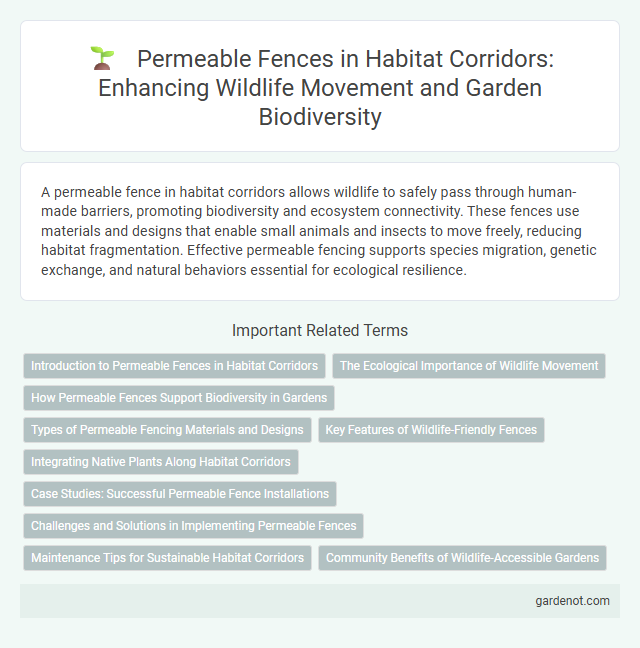A permeable fence in habitat corridors allows wildlife to safely pass through human-made barriers, promoting biodiversity and ecosystem connectivity. These fences use materials and designs that enable small animals and insects to move freely, reducing habitat fragmentation. Effective permeable fencing supports species migration, genetic exchange, and natural behaviors essential for ecological resilience.
Introduction to Permeable Fences in Habitat Corridors
Permeable fences in habitat corridors facilitate the movement of wildlife by allowing animals to pass through barriers that would otherwise restrict their natural pathways, promoting genetic exchange and ecosystem connectivity. These fences are designed with materials such as mesh or spaced slats that maintain the integrity of the corridor while minimizing habitat fragmentation. Integrating permeable fences into habitat corridors supports biodiversity conservation by linking isolated populations and enhancing landscape permeability for various species.
The Ecological Importance of Wildlife Movement
Permeable fences play a crucial role in habitat corridors by allowing wildlife movement essential for ecological connectivity and genetic diversity. These structures reduce habitat fragmentation by enabling species to access various resources, migrate, and adapt to environmental changes. Maintaining permeability in fences supports ecosystem health and resilience by facilitating natural animal behaviors within interconnected landscapes.
How Permeable Fences Support Biodiversity in Gardens
Permeable fences enhance biodiversity in gardens by allowing small animals, insects, and pollinators to move freely between habitats, facilitating natural migration and gene flow. These fences support diverse plant and animal populations by maintaining habitat connectivity, which is crucial for species survival and ecosystem health. Incorporating permeable designs helps create continuous wildlife corridors, reducing habitat fragmentation and promoting ecological balance.
Types of Permeable Fencing Materials and Designs
Permeable fences used in habitat corridors often include materials such as wire mesh, wooden slats, and polycarbonate panels designed to allow wildlife movement while maintaining boundary integrity. Wire mesh fences feature varying gauge sizes and grid patterns to accommodate small mammals and reptiles, whereas wooden slats provide partial visibility and airflow suitable for bird habitats. Advanced designs incorporate modular panels with adjustable openings, supporting species-specific permeability and promoting ecological connectivity within fragmented landscapes.
Key Features of Wildlife-Friendly Fences
Permeable fences designed for habitat corridors feature mesh or spaced slats that allow small mammals, reptiles, and amphibians to pass through, maintaining natural movement patterns. These wildlife-friendly fences incorporate materials that minimize injury risk, such as smooth edges and flexible fabrics, while providing structural durability against environmental elements. Strategic height and gap configurations prevent larger predators or invasive species from crossing, enhancing the ecological balance within connected habitats.
Integrating Native Plants Along Habitat Corridors
Permeable fences enhance habitat corridors by allowing wildlife movement while supporting ecological functions through integrated native plants, which improve biodiversity and soil stability. Native plant species such as milkweed, goldenrod, and switchgrass provide essential food and shelter, encouraging a resilient ecosystem within these corridors. Incorporating diverse native flora along permeable fences promotes habitat connectivity and strengthens the overall environmental health of fragmented landscapes.
Case Studies: Successful Permeable Fence Installations
Case studies on permeable fence installations highlight their effectiveness in maintaining wildlife movement while enhancing habitat connectivity across fragmented landscapes. Projects in regions like the Pacific Northwest demonstrate increased amphibian and small mammal passage rates, contributing to local biodiversity recovery. Data shows that using materials such as spaced wooden slats or wire mesh optimizes permeability without compromising security or boundary integrity.
Challenges and Solutions in Implementing Permeable Fences
Implementing permeable fences in habitat corridors faces challenges such as balancing wildlife movement and human security, ensuring durability against environmental stressors, and maintaining cost-effectiveness. Solutions involve using modular designs with flexible materials that allow species-specific passage while deterring predators, incorporating advanced sensor technology for monitoring fence integrity, and leveraging community-based funding for sustainable maintenance. These strategies enhance connectivity for biodiversity conservation without compromising safety or budget constraints.
Maintenance Tips for Sustainable Habitat Corridors
Regular inspection and vegetation control are essential for maintaining permeable fences in habitat corridors, ensuring unobstructed wildlife movement and structural integrity. Use eco-friendly cleaning methods to avoid chemical runoff that can harm local flora and fauna. Repair any damages promptly with materials that blend into the natural environment to preserve corridor functionality and sustainability.
Community Benefits of Wildlife-Accessible Gardens
Permeable fences in habitat corridors enhance wildlife-accessible gardens by allowing natural movement of animals while maintaining community safety and aesthetics. These fences support biodiversity by connecting fragmented green spaces, enabling pollinators and small mammals to thrive within urban neighborhoods. Increased wildlife presence fosters community engagement, education, and promotes ecological balance in residential areas.
Permeable fence Infographic

 gardenot.com
gardenot.com